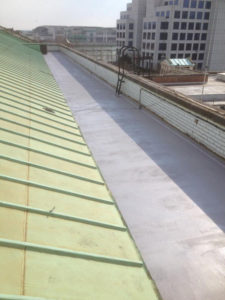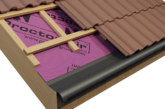 LABM finds out how mastic asphalt helped ensure long-lasting waterproof protection at the O2 Guildhall in Southampton.
LABM finds out how mastic asphalt helped ensure long-lasting waterproof protection at the O2 Guildhall in Southampton.
Mastic asphalt is considered to be one of the most traditional roofing materials available, having provided protection from water penetration for centuries. For some, it is perceived as an old fashioned material, but like many long-lasting materials that have stood the test of time, it is being re-imagined and modified in a modern way.
Traditionally consisting of graded limestone aggregate bound together with bitumen, today’s mastic asphalt systems are now manufactured using advanced polymer modified formulations to ensure all the performance characteristics of traditional asphalt systems, with the added benefits of increased flexibility, enhanced handling and sustainability.
Mastic asphalt is typically known for its durability and one project that effectively demonstrates this is the O2 Guildhall in Southampton. Originally opened in 1937 as a town hall and location for municipal functions, the Guildhall is located within the East Wing of Southampton’s Civic Centre and is Grade II listed. The O2 Guildhall is now used as a performing arts theatre and has hosted some of the biggest names in music from Pink Floyd and David Bowie in the 1970s to today’s bands such as the Killers, the Manic Street Preachers and the Kaiser Chiefs.
The roof of the O2 Guildhall required refurbishment and had previously been protected with mastic asphalt, which had provided effective weatherproof protection for over 40 years. As the existing mastic asphalt had performed so well over such a long period of time and the works had to remain sensitive to the character of the building and provide an aesthetic roof covering, Southampton Council wanted to use the same material to ensure a similar lifespan.

Roofing system
A mastic asphalt system manufactured by Mastic Asphalt Council member IKO was chosen for application to various roof areas at the Guildhall totalling 600m2. The specially formulated mastic asphalt roofing system utilises advanced polymer technology to provide a combination of long-term durability, increased fatigue resistance, improved temperature stability and ease of installation. Its low temperature flexibility ensures that the system can be installed in cold weather.
The existing mastic asphalt was stripped by a MAC contractor member and re-laid with IKO’s high performance mastic asphalt system. The system build-up also comprised application of a vapour control layer and 100mm of insulation. Upstand heights were raised where possible to conform to good roofing practice.
The material was ideal for this project as it is well suited for Grade listed and heritage applications. Buckingham Palace is testament to the longevity of mastic asphalt. On top of the Royal household is a rooftop of mastic asphalt that has kept the building dry for well over 80 years. Other heritage applications include the Houses of Parliament, the Tower of London, Tower Bridge and Edinburgh Castle.

Durability and wear resistance
Although mastic asphalt is a traditional material that was first patented in 1837 and has been around for years in more simple guises than today, it offers durability and wear resistance far beyond modern alternatives.
The Building Research Establishment (BRE) has officially stated that mastic asphalt roofing is capable of lasting 50-60 years, but the Mastic Asphalt Council has many examples well in excess of this. For instance, mastic asphalt was first laid at London’s St Paul’s Cathedral in 1906 and it provided well over 100 years’ of effective waterproofing before it needed replacement.
Mastic asphalt’s green credentials were also an advantage for this project, as it is carbon neutral and when it has reached the end of its useful life, it can be recycled or used as roof screed. Ten years ago the mastic asphalt sector became the first industry in the world to achieve the CarbonZero standard.
 Flame resistant
Flame resistant
Fire safety was another consideration and the high mineral content of mastic asphalt renders it virtually incombustible. Mastic asphalt fulfils all the external fire resistance required for a roof covering and achieves the highest rating (AA) when tested in accordance with BS 476: Part 3. It has also been tested in accordance with draft European standards prEN1187-1 and prEN1187-2. No significant spread of flame was observed and no flame penetration occurred.
As mastic asphalt is laid in molten form, it is often confused with other types of waterproofing membrane that require naked flame or torch on application. In reality, there is no naked flame at the point of installation and because mastic asphalt is so highly flame resistant, there is little or no potential of fire risk.
This is particularly important for roofing projects on public buildings such as the O2 Guildhall, due to the safety aspect and minimal disruption to normal activities in the underlying building. Roofs can be quickly and efficiently waterproofed with mastic asphalt allowing other trades on site, often within hours. The flowing characteristics of mastic asphalt also make it easy for installing contractors to tackle roof surfaces which are complex, stepped or with multiple protrusions.
The Mastic Asphalt Council (MAC) is the trade association for the mastic asphalt industry in the UK. Representing more than 70 companies operating in the sector, MAC members include mastic asphalt manufacturers, specialist application contractors and associated suppliers of equipment and services.









